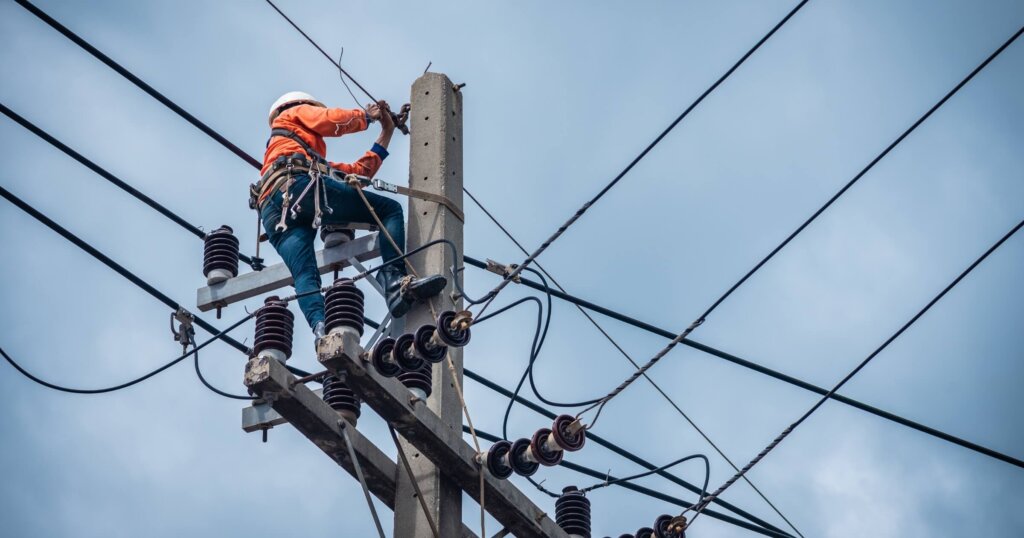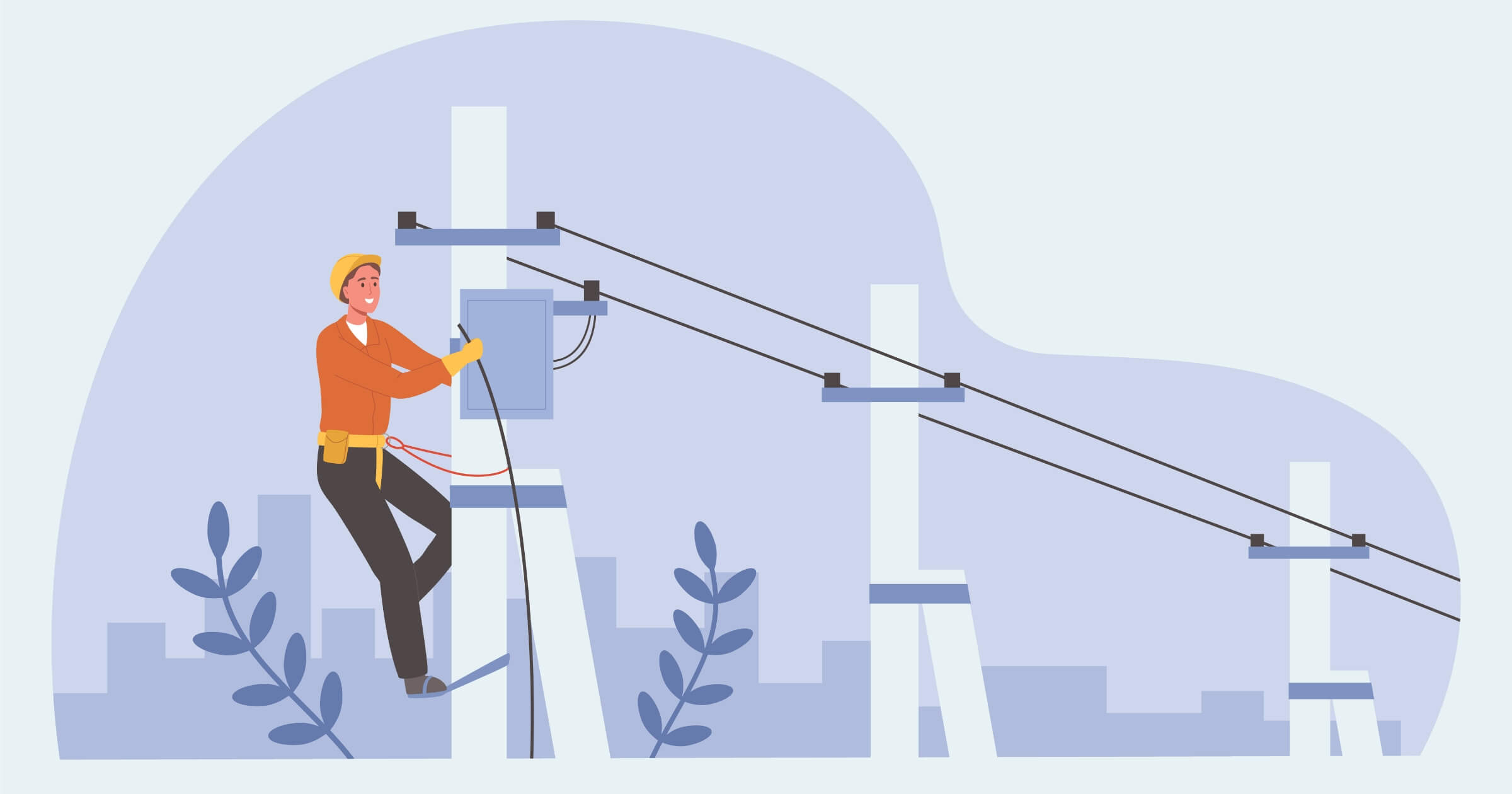A lineman (or lineworker) is a tradesperson who constructs and maintains the electrical power lines that deliver electricity across communities. They often work at heights on utility poles or towers, repairing and installing the wires and equipment that keep our lights on. This hands-on career is not only vital but also growing in demand. Many current linemen are reaching retirement age, and massive investments are being made to modernize the electrical grid.
In fact, the occupation of electrical power-line installer is projected to grow about 8% this decade (roughly double the average for all jobs). For those in the USA interested in this high-demand field, lineman apprenticeship programs offer a key entry route. Below, we outline everything you need to know – from what an apprenticeship entails to requirements, challenges, and how to get started.
Quick look
- Linemen build and maintain the electrical power lines that keep homes and businesses running—and the field is growing fast due to aging workers and grid upgrades.
- Apprenticeships combine paid, hands-on work with classroom learning and typically take 3–4 years to complete.
- Top programs include union-sponsored routes like IBEW, utility-run options like TVA, and schools like Northwest Lineman College and SLTC.
- Requirements usually include being 18+, having a high school diploma or GED, a valid driver’s license (often a CDL), and passing drug and physical tests.
- Journeyman linemen can earn around $85,000 annually, with strong job security and opportunities across the U.S.
What is a lineman apprenticeship?
A lineman apprenticeship is a formal training program that prepares you to become a qualified journeyman lineman. It typically combines paid on-the-job training (OJT) with classroom instruction. As an apprentice, you work under experienced journeymen, learning the trade by actually doing the work while also taking related courses.
On the job, you’ll start with basic tasks (like assisting ground crews, handling tools, and learning to climb poles) and gradually take on more responsibilities as your skills grow. You’ll learn to install and repair power lines, operate bucket trucks, use heavy equipment, and follow strict safety procedures. In the classroom, apprentices study electrical theory, safety protocols, and trade knowledge.
Most lineman apprenticeships are sponsored either by unions, such as the International Brotherhood of Electrical Workers (IBEW), in partnership with utility contractors, or by non-union employers like utility companies or contractors. In both cases, an apprenticeship is a paid position – you earn a wage while you learn. By the end of the program, after completing all required hours and exams, you’ll achieve journeyman lineman status, meaning you are fully qualified to work independently in the trade.

How long is a lineman apprenticeship?
Lineman apprenticeship programs are lengthy – typically 3 to 4 years on average – because of the extensive training required to master this trade. Most programs require around 6,000 to 8,000 hours of on-the-job work. For example, one established program from the Hawaii Electricians Training Fund consists of 7,000 hours of field training (about 3½ to 4 years of full-time work) combined with roughly 480 hours of classroom instruction.
During these years, apprentices gradually progress from basic to more advanced tasks and gain increasing responsibility. As you advance, your pay rate typically increases at each step. For instance, in a union apprenticeship, an entry-level apprentice might start at about 60% of a journeyman’s wage for the first 1,000 hours, then bump up to 65% in the next period, and so on.
By the final period of apprenticeship, you could be earning around 80–90% of the full journeyman rate.
Top 9 lineman apprenticeship programs across the U.S.
1. North American Lineman Training Center (NALTC)
- Location: McEwen, Tennessee
- Length: 15 weeks
- Apply here: Through the NALTC application
2. Texas A&M Engineering Extension Service (TEEX) Lineworker Academy
- Location: College Station, Texas
- Length: 15 weeks
- Apply here: TEEX Lineworker Academy registration
3. Southeast Lineman Training Center (SLTC)
- Location: Trenton, Georgia
- Length: 15 weeks
- Apply here: SLTC portal
4. Northwest Lineman College (NLC)
- Locations: Meridian, Idaho; Oroville, California; Denton, Texas; Edgewater, Florida
- Length: 15 weeks
- Apply here: NLC admissions portal
5. Tennessee Valley Authority (TVA) Lineman Apprentice Program
- Location: Various locations across the TVA service area
- Length: 3 to 4 years
- Apply here: TVA careers
6. International Brotherhood of Electrical Workers (IBEW) Apprenticeship Programs
- Location: Nationwide
- Length: 4 to 5 years
- Apply here: IBEW apprenticeship information
7. Tacoma Power Lineman Apprenticeship
- Location: Tacoma, Washington
- Length: 3.5 years
- Application: Tacoma Power apprenticeships
8. Seattle City Light Apprenticeship Programs
- Location: Seattle, Washington
- Length: Varies by program
- Apply here: Seattle City Light careers
9. Bonneville Power Administration
- Location: Washington, Oregon, Idaho, Montana
- Length: 4 years
- Apply here: BPA lineworkers apprenticeship program
General entry requirements for lineman apprenticeship programs
While exact prerequisites vary by program, most lineman apprenticeships in the U.S. require the following:
- Age: Must be at least 18 years old
- Education: A minimum of a high school diploma or GED is required
- Driver’s License: A valid driver’s license is almost always required. Many employers strongly prefer or require that you either have a Class A Commercial Driver’s License (CDL) or be able to obtain one soon after starting. Linemen frequently need to drive bucket trucks or heavy utility vehicles, so a CDL is a valuable credential.
- Physical Fitness: You must be in good physical condition and capable of performing the demanding work. This means you should be able to climb and work at heights, lift heavy equipment, and endure outdoor labor in various weather. Some apprenticeships will have you pass a physical ability test (for example, climbing a utility pole or ladder, lifting a certain weight, etc.)
- Drug-Free: Candidates must pass a drug screening test. Safety is paramount in this field, and working under the influence of drugs or alcohol is not tolerated. Expect random drug tests throughout the apprenticeship as well.
- Clean Record: While not always explicitly stated, many employers prefer candidates with a clean driving and criminal record (due to the trust and safety involved in accessing secure facilities or responding to emergencies). Minor infractions might be overlooked, but anything major could be an issue.
Types of lineman apprenticeships
Not all lineman apprenticeships are identical. There are a few different types of programs and career paths, and it’s important to understand their differences before choosing.
Union vs. non-union apprenticeships
Lineman apprenticeships are often run through union organizations (like the IBEW in cooperation with the National Electrical Contractors Association) or through non-union (also called “open shop”) employers. In a union apprenticeship, you typically join the union and are placed into a training program with standardized pay scales and benefits. The union route often comes with excellent benefits — for example, union linemen get high-quality health insurance (with premiums fully covered by the industry) and strong retirement pensions as part of their package.
Union apprentices and journeymen usually enjoy higher hourly wages and robust job security, though they do pay union dues and generally must work for signatory (union-affiliated) contractors.
In contrast, non-union apprenticeships are run by individual companies or contractors without union involvement. A non-union program might offer a bit more flexibility in choosing where you work (you’re not limited to union-contract jobs and won’t pay dues), but the pay rate and benefits can vary widely by employer. Non-union apprenticeships still follow a similar training format (combining OJT and classes), though some may be shorter or less standardized. Many large utility companies in the U.S. have their own apprenticeship programs – whether unionized or not – so it’s worth researching the companies in your area.
Power distribution vs. telecommunications linework
When people say “lineman,” they often mean electrical power lineman – the workers who install and repair the electric transmission and distribution lines. However, there are also telecommunications line installers who work on phone, cable TV, and internet fiber lines.
Electrical linemen deal with high-voltage power lines, both overhead on poles and underground, connecting power plants to homes and businesses. Telecom linemen (sometimes called line installers or cable installers) handle low-voltage fiber optic and copper cables for communication networks. They often use similar skills (climbing poles, stringing lines), but the job typically involves different materials and safety standards.
For instance, telecom linework commonly focuses on installing fiber optic cables (which transmit data via light), and many telecom lines are run underground. Power linemen, on the other hand, work with live electrical currents, which is more dangerous and requires specialized high-voltage safety training.
Because of these differences, power lineman apprenticeships are usually more extensive. They may offer higher pay than training programs for telecom line installers. It’s important to decide which path interests you: if your goal is to work on the electric grid, pursue an electrical lineman apprenticeship; if you prefer communications (or want to avoid high-voltage work), you might look at telecom line installer training. (Note: Some apprenticeship programs might expose you to both power and telecom work, but most specialize in one or the other.)
What will your daily life look like during those 3–4 years?
In the beginning, much of your time is spent learning the ropes (literally!). You’ll practice climbing utility poles and towers, learn to use safety harnesses and fall-arrest equipment, and get comfortable working at heights. Periodically, you will also attend training classes or labs – often, this might be a week of classroom training every few months, or some programs do evening/weekend classes. In class, you’ll study electrical theory, wiring diagrams, transformer configurations, first aid/CPR, and safety regulations like OSHA rules. There may be tests or exams at intervals to ensure you’re grasping the material.
Expect an intense and immersive learning experience. The work is very hands-on, mostly outdoors in all kinds of weather. You’ll likely work full-time hours for your employer, which could include early mornings, long days, and occasionally being on-call for emergencies (like storm outages).
You might also travel to different job sites; linemen often go wherever the work is needed, which can mean working out of town for stretches. By the end of the apprenticeship, you will have a well-rounded experience – from climbing poles and rescuing an injured worker in drills, to understanding the intricacies of electrical distribution systems. Completing this journey is challenging but equips you with the skills to be a journeyman lineman who can work safely and independently.
Average lineman salary in the U.S.
One of the big incentives for putting in the effort to become a lineman is the pay. Linemen are typically well-compensated for their skills and the risks they take.
- According to industry data, entry-level linemen (0–5 years of experience) in the U.S. average about $52,000 per year.
- Journeyman Lineman Pay: Once you complete the apprenticeship and become a journeyman lineman, your pay increases to the full scale for your trade. The exact wages vary by region, employer, and union contracts. Nationally, electrical power-line installers and repairers (which includes journeymen linemen) have a median annual salary of about $85,000, which works out to roughly $41 per hour.
Is a lineman apprenticeship right for you?
Choosing to become a lineman means signing up for a challenging and fulfilling career. Through a lineman apprenticeship program, you’ll earn while you learn, eventually joining the ranks of the skilled journeymen who keep the country’s power and communications infrastructure running. The road isn’t easy – expect tough days, hard work, and a serious commitment to safety and learning. But if you stick with it, you’ll gain a trade that offers job security, brotherhood/sisterhood, and excellent pay.
For those in the USA eyeing this path, now is a great time to start. The need for lineworkers is on the rise, and apprenticeships are the ticket in.
Want to learn more about apprenticeships in construction? Join our newsletter to get the latest information on trade apprenticeships delivered straight to your inbox!



1 comment